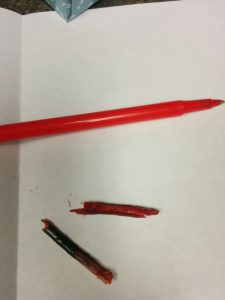Eye for an eye – by Dr. Amanda Glew
If there is an organ that makes people shiver when dealing with it, it is the eye. I have had experienced technicians become nauseated when I perform surgery on the eye. I have seen vets go green at the sight of an enucleation (removal of the eye). Fortunately for me, I love dealing with eyes. I love performing surgery on them and I am always amazed at how the cornea, the clear part of the eye, can be sewn together after a trauma and heal with a minimal scar. But one thing that I have learned from experience is that they take time to heal, and need lots of care, so often become costly.
So the other day when I was asked to look at a new client’s eye on an already booked night, of course I accepted. The middle aged chocolate Labrador arrived at the clinic with a history of running outside and returning with a closed left eye. In order to make sure our fit-ins do not make the vet overly tardy, our technicians perform a triage to see the severity of the condition. One of our experienced technicians from the Timberlea Veterinary clinic quickly looked at this dog’s tearing and swollen left eye and asked me to look at it sooner rather than later.
In general, clients know me, and realize that after 30 years’ experience, I am pretty good at judging a situation. I trust my trained Animal Health Technicians to restrain an animal minimally and appropriately in order to expedite an exam. However, new clients sometimes don’t realize that a dog throwing his head around makes it virtually impossible for me to examine an eye properly. This was the case with this dog, and he immediately demanded that I freeze the eye. If the globe is punctured, using a local anesthetic is not a wise choice if you want to save the eye. So I explained this to the owner, and ask that he allow my assistant to do her job. I looked at the eye, saw that the globe was intact, and saw what appeared to be a splinter of wood in the lower lid. I offered a sedation for the dog at this time, but the owner asked me to try to extract the foreign body with a local, so I did.
I love foreign bodies. I have taken out the most amazing things from guts of animals – from sticks in the legs, to needles in throats. I figured I had seen most things possible by this time. But when I took my hemostats and grasped the piece of wood in the lower lid just below the eye of this dog, I was not ready for what came out. Almost immediately the dog

pulled back, I held on, and a 3-inch piece of stick came out from behind the eye of this dog. It was a case of the tip on the iceberg. What I thought was a splinter was just the beginning of a large piece of wood, which had impaled itself under the eye into the orbit of the dog.
Any of us who have removed splinters know that feeling of tingling in your skin when you remove a large piece. My shudder and that of the owners was followed by a stunned silence. Fortunately, like most Labradors, once the offending piece was out, he wagged his tail happily and accepted a biscuit. I finished off the ocular exam, and except for a sluggish pupil, likely the result of some trauma in the optic nerve in the back of the eye, the dog was fine.
After all the excitement and exclamation about how lucky the dog was not to have lost his eye, I asked the new owner what was the name of the dog. His name is, most appropriately, Chance.
 Montreal Dog Blog Montreal's Online Dog Park
Montreal Dog Blog Montreal's Online Dog Park




